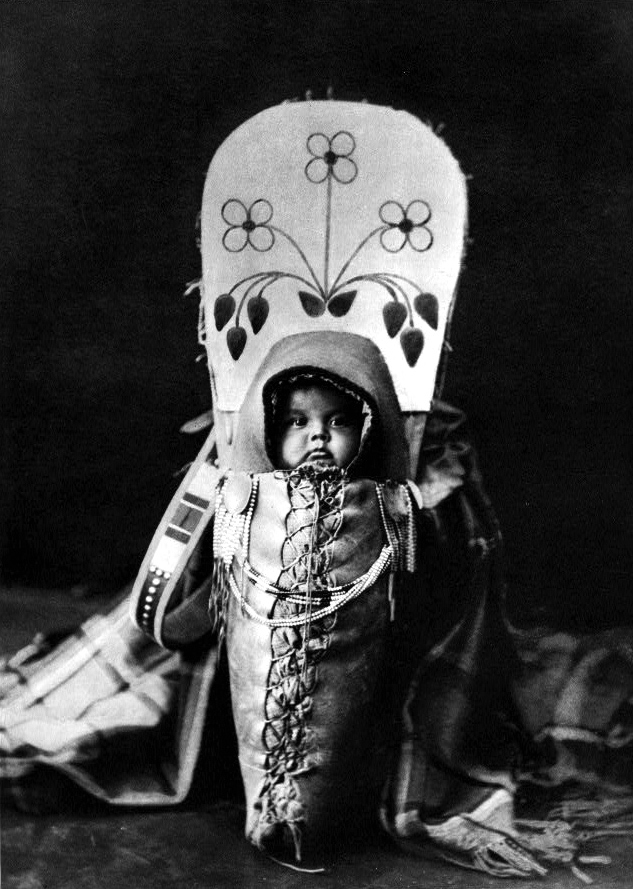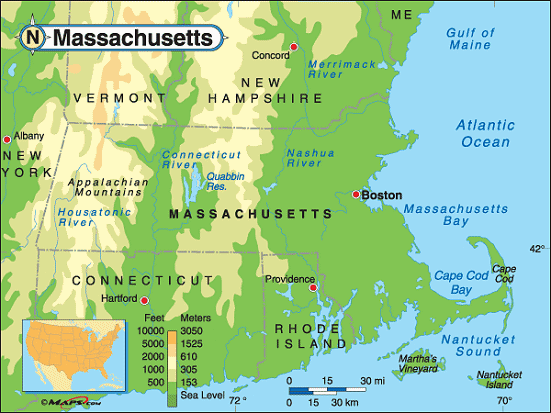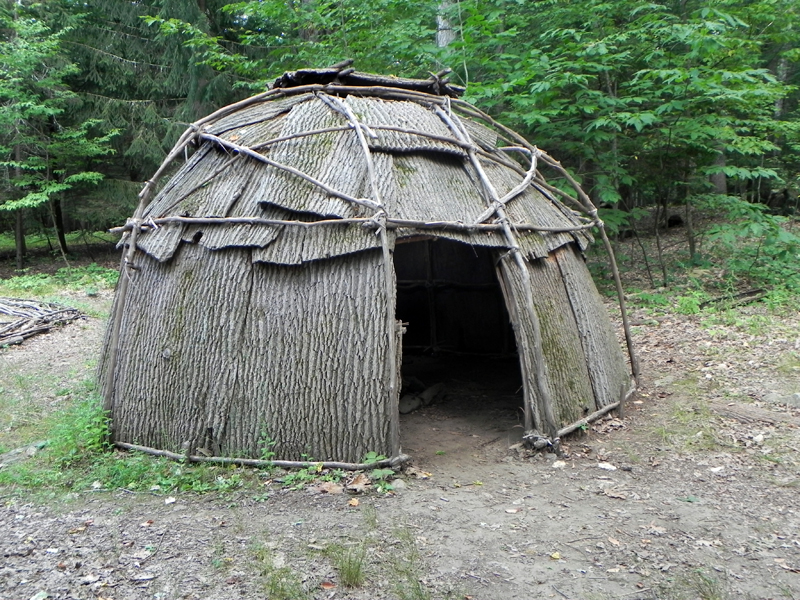Edited By: Taylor Bassett
Instead of going toward the Bay, which was that I desired, I must go with them five or six miles down the river into a mighty thicket of brush; where we abode almost a fortnight1. Here one asked me to make a shirt for her papoose, for which she gave me a mess of broth, which was thickened with meal made of the bark of a tree, and to make it better, she had out into it about a handful of peas, and a few roasted ground nuts.

According to Wikipedia, “a papoose [pictured here]… is an American English loanword whose present meaning is “a Native American child” (regardless of tribe) or, even more generally, any child, usually used as a term of endearment, often in the context of the child’s mother. The word came originally from the Narragansett tribe, just one of the current 573 federally recognized tribes. In 1643, Roger Williams recorded the word in his A Key Into the Language of America, helping to popularize it”. (This image has been taken from Wikipedia)
I had not seen my son a pretty while, and here was an Indian of whom I made inquiry after him, and asked him when he saw him. He answered me that such a time his master roasted him, and that himself did eat a piece of him, as big as his two fingers, and that he was very good meat2. But the Lord upheld my Spirit, under this discouragement; and I considered their horrible addictedness to lying, and that there is not one of them that makes the least conscience of speaking of truth. In this place, on a cold night, as I lay by the fire, I removed a stick that kept the heat from me. A squaw3 moved it down again, at which I looked up, and she threw a handful of ashes in mine eyes. I thought I should have been quite blinded, and have never seen more, but lying down, the water run out of my eyes, and carried the dirt with it, that by the morning I recovered my sight again. Yet upon this, and the like occasions, I hope it is not too much to say with Job4, “Have pity upon me, O ye my Friends, for the Hand of the Lord has touched me5.” And here I cannot but remember how many times sitting in their wigwams, and musing on things past, I should suddenly leap up and run out, as if I had been at home, forgetting where I was, and what my condition was; but when I was without, and saw nothing but wilderness, and woods, and a company of barbarous heathens6, my mind quickly returned to me, which made me think of that, spoken concerning Sampson7, who said, “I will go out and shake myself as at other times, but he wist not that the Lord was departed from him.” About this time I began to think that all my hopes of restoration would come to nothing8.

The general area that Rowlandson was located during her time of captivity–Massachusetts Bay, the Connecticut River, Hadley, and Albany (NY). (This image has been taken from Netstate)
I thought of the English army, and hoped for their coming, and being taken by them, but that failed. I hoped to be carried to Albany as the Indians had discoursed before, but that failed also. I thought of being sold to my husband, as my master spake, but instead of that, my master himself was gone, and I left behind, so that my spirit was now quite ready to sink. I asked them to let me go out and pick up some sticks, that I might get alone, and pour out my heart unto the Lord9. Then also I took my Bible to read, but I found no comfort here neither, which many times I was wont to find. So easy a thing it is with God to dry up the streams of Scripture comfort from us. Yet I can say, that in all my sorrows and afflictions, God did not leave me to have my impatience work towards Himself, as if His ways were unrighteous. But I knew that He laid upon me less than I deserved. Afterward, before this doleful time ended with me, I was turning the leaves of my Bible, and the Lord brought to me some Scriptures, which did a little revive me, as that [in] Isaiah 55.8: “For my thoughts are not your thoughts, neither are your ways my ways, saith the Lord.” And also that [in] Psalm 37.5: “Commit thy way unto the Lord; trust also in him; and he shall bring it to pass.” About this time they came yelping10 from Hadley11, where they had killed three Englishmen, and brought one captive with them, viz.12 Thomas Read. They all gathered about the poor man, asking him many questions. I desired also to go and see him; and when I came, he was crying bitterly, supposing they would quickly kill him. Whereupon I asked one of them, whether they intended to kill him; he answered me, they would not. He being a little cheered with that, I asked him about the welfare of my husband. He told me he saw him such a time in the Bay, and he was well, but very melancholy13. By which I certainly understood (though I suspected it before) that whatsoever the Indians told me respecting him was vanity and lies. Some of them told me he was dead, and they had killed him; some said he was married again, and that the Governor wished him to marry; and told him he should have his choice, and that all persuaded I was dead. So like were these barbarous creatures to him who was a liar from the beginning.

The wigwam pictured here is similar to where Rowlandson spent most of her time–if not travelling–during her captivity. (This image has been taken from FirstNationCulturalTours)
As I was sitting once in the wigwam here, Philip’s141516 maid came in with the child in her arms, and asked me to give her a piece of my apron, to make a flap for it. I told her I would not. Then my mistress bade me give it, but still I said no. The maid told me if I would not give her a piece, she would tear a piece off it. I told her I would tear her coat then. With that my mistress rises up, and take up a stick big enough to have killed me, and struck at me with it. But I stepped out, and she struck the stick into the mat of the wigwam. But while she was pulling of it out I ran to the maid and gave her all my apron, and so that storm went over17.
Works Cited
“King Philip’s War.” History. A&E Television Networks. 09 November, 2009, https://www.history.com/topics/native-american-history/king-philips-war.
Stratton, Billy J. Buried in the Shades of Night: Contested Voices, Indian Captivity, and the Legacy of King Philip’s War. University of Arizona Press, Tucson, 2013.
“Papoose.” Wikipedia. Wikimedia Foundation. 03 September, 2020, https://en.wikipedia.org/wiki/Papoose.
Acknowledgements
Thanks to Project Gutenberg for providing the digitized version of this text free of charge. Without their generosity, this project would not be possible
A fortnight in this case is a two week time period, not the popular video game ↩
Rowlandson and the English colonists often saw Indigenous people as cannibals. Narratives such as Rowlandson’s often used captivity narratives to confirm that the Indigenous peoples were cannibals in order to justify the later actions of the colonists. Billy J. Stratton’s Buried in the Shades of Night draws more attention to the issue of the “othering” of Indigenous peoples by the English colonists and specifically states that “the account of Rowlandson’s experiences, as well as the Indian captivity narratives of other English settlers provided the American reading public with lurid and sensational reports of person survival, juxtaposing acts of Indian savagery with celebrated feats of perseverance and heroism” (24). Please be aware that Stratton’s book may only be accessible by Vancouver Island University students with the proper credentials. You can find the link to the eBook here ↩
The word “squaw” was a specific word used by the English as an ethnic and sexual slur towards Indigenous women, but there has been some debate as to whether or not this word is offensive ↩
Pronounced “Jobe” ↩
Rowlandson quotes a verse from the Christian Bible here, specifically Job 19:21. In this specific line, Job asks for pity from his friends as he has no one and would enjoy some sympathy. Rowlandson does the same thing with the “terrible” situation that she identifies herself to be in; she longs for the company of fellow Christians and craves their sorrows upon her. ↩
Although the first occurrence in this remove, this is not the first or last time that Rowlandson has referred to her Indigenous captors as “barbarous heathens”. Rowlandson was a devout Christian as is evident with her references to scripture and her multiple remarks of not being in Christian company. In this case, the word “heathen” is appropriate language used in Rowlandson’s case as it is directly defined as one who does not believe in God, which Rowlandson (and therefore the English) believed the Indigenous people to be. ↩
Sampson/Samson is described as similar to a hero for being brave in certain situations. Rowlandson mentioning Sampson in this case can be seen as an effort on her part to try and draw a comparison between herself and Sampson ↩
Rowlandson can often be observed to be questioning the outcome of her life during her time of captivity, but a fear that is quite prevalent for her is the fear of not being forgiven by God for being in the same company of non-believers and adapting to their “heathen” ways (even though many Indigenous people did believe in God, but because they weren’t white, it was not good enough for Rowlandson). ↩
Rowlandson used scripture as the only mode of comfort during her time with the Indigenous people. Even when Rowlandson reports the Indigenous people being kind and giving towards her, she resorts to scripture to explain why they may have acted the way they did towards her. ↩
Rowlandson referring to the Indigenous people as “yelping” presents an effort of trying to dehumanize them. Referring to them as animals, cannibals and heathens was a tactic used by English colonists in order to villainize the Indigenous people and victimize themselves. Narratives such as Rowlandson’s is a strong example of this. ↩
Not identified in the map, but Hadley is right beside the Connecticut River. ↩
“viz.” is a term used to indicate an introduction or an explanation. ↩
Synonym for sorrowful ↩
Here, Philip is also known as King Philip, who is also known as Indigenous leader Metacom. ↩
King Philip, a.k.a. Metacom, is famously known for the King Philip’s War (1675), which was an effort on Indigenous people to “avoid recognizing English authority and stop English settlement on their native lands”. Rowlandson’s The Sovereignty and Goodness of God takes places in the midst of this war ↩
As is stated by Billy J. Stratton in Buried in the Shades of Night, “as testimony to this war, English writers produced hundreds of literary texts detailing the combat, functioning as a form of validation of Puritan claims and justifications of the prosecution of the war through the graphic chronicling of ‘Indian depredations’ and cruelties that functioned to demonize, marginalize, and effectively silence Native subjectivities” (pp 7-8). Stratton also draws attention to what he coins as “Native survivance”, specifically drawing from William Apess’ Eulogy on King Philip (1836), which “characterize[d] the Puritans’ actions during and immediately after King Phillip’s War as elemental acts of racism in American history” (Stratton 8). Apess’ Eulogy has been linked for context and specific statements made by him that praise King Philip’s bravery and resiliency for his community in addition to providing examples of racism brought on by the Puritans/English colonists. ↩
Spelling, capitalization, italics, and the general presentation of this remove have been retained from Project Gutenberg’s 2003 eBook release ↩
